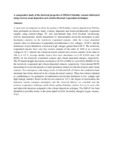Please use this identifier to cite or link to this item:
https://cris.library.msu.ac.zw//handle/11408/1633Full metadata record
| DC Field | Value | Language |
|---|---|---|
| dc.contributor.author | Mtangi, W. | - |
| dc.contributor.author | Auret, F. D. | - |
| dc.contributor.author | Janse van Rensburg, P. J. | - |
| dc.contributor.author | Coelho, S. M. M. | - |
| dc.contributor.author | Legodi, M. J. | - |
| dc.contributor.author | Nel, J. M. | - |
| dc.contributor.author | Meyer, W. E. | - |
| dc.contributor.author | Chawanda, Albert | - |
| dc.date.accessioned | 2016-06-24T12:51:07Z | - |
| dc.date.available | 2016-06-24T12:51:07Z | - |
| dc.date.issued | 2011 | - |
| dc.identifier.issn | 0021-8979 | - |
| dc.identifier.uri | http://hdl.handle.net/11408/1633 | - |
| dc.description.abstract | A systematic investigation to check the quality of Pd Schottky contacts deposited on ZnO has been performed on electron beam (e-beam) deposited and resistively/thermally evaporated samples using current-voltage, IV, and conventional deep level transient spectroscopy (DLTS) measurements. Room temperature IV measurements reveal the dominance of pure thermionic emission on the resistively evaporated contacts, while the e-beam deposited contacts show the dominance of generation recombination at low voltages, <0.30 V, and the dominance of pure thermionic emission at high voltages, greater than 0.30 V. The resistively evaporated contacts have very low reverse currents of the order of 10 10 A at a reverse voltage of 1.0 V whereas the e-beam deposited contacts have reverse currents of the order of 10 6 A at 1.0 V. Average ideality factors have been determined as (1.43 6 0.01) and (1.66 60.02) for the resistively evaporated contacts and e-beam deposited contacts, respectively. The IV barrier heights have been calculated as (0.721 6 0.002) eV and (0.624 60.005) eV for the resistively evaporated and e-beam deposited contacts, respectively. Conventional DLTS measurements reveal the presence of three prominent defects in both the resistive and e-beam contacts. Two extra peaks with energy levels of 0.60 and 0.81 eV below the conduction band minimum have been observed in the e-beam deposited contacts. These have been explained as contributing to the generation recombination current that dominates at low voltages and high leakage currents. Based on the reverse current at 1.0 V, the degree of rectification, the dominant current transport mechanism and the observed defects, we conclude that the resistive evaporation technique yields better quality Schottky contacts for use in solar cells and ultraviolet detectors compared to the e-beam deposition technique. The 0.60 eV has been identified as possibly related to the unoccupied level for the doubly charged oxygen vacancy, Vo 2+. | en_US |
| dc.language.iso | en | en_US |
| dc.publisher | American Institute of Physics | en_US |
| dc.relation.ispartofseries | Journal of Applied Physics;Vol. 110; p. 094504-1-094504-5 | - |
| dc.subject | Electrical properties | en_US |
| dc.title | A comparative study of the electrical properties of Pd/ZnO Schottky contacts fabricated using electron beam deposition and resistive/thermal evaporation techniques | en_US |
| dc.type | Article | en_US |
| item.grantfulltext | open | - |
| item.openairetype | Article | - |
| item.fulltext | With Fulltext | - |
| item.openairecristype | http://purl.org/coar/resource_type/c_18cf | - |
| item.cerifentitytype | Publications | - |
| item.languageiso639-1 | en | - |
| Appears in Collections: | Research Papers | |
Files in This Item:
| File | Description | Size | Format | |
|---|---|---|---|---|
| A comparative study of the electrical properties of Pd.pdf | Abstract | 6.37 kB | Adobe PDF |  View/Open |
Page view(s)
150
checked on Dec 11, 2025
Download(s)
22
checked on Dec 11, 2025
Google ScholarTM
Check
Items in MSUIR are protected by copyright, with all rights reserved, unless otherwise indicated.



